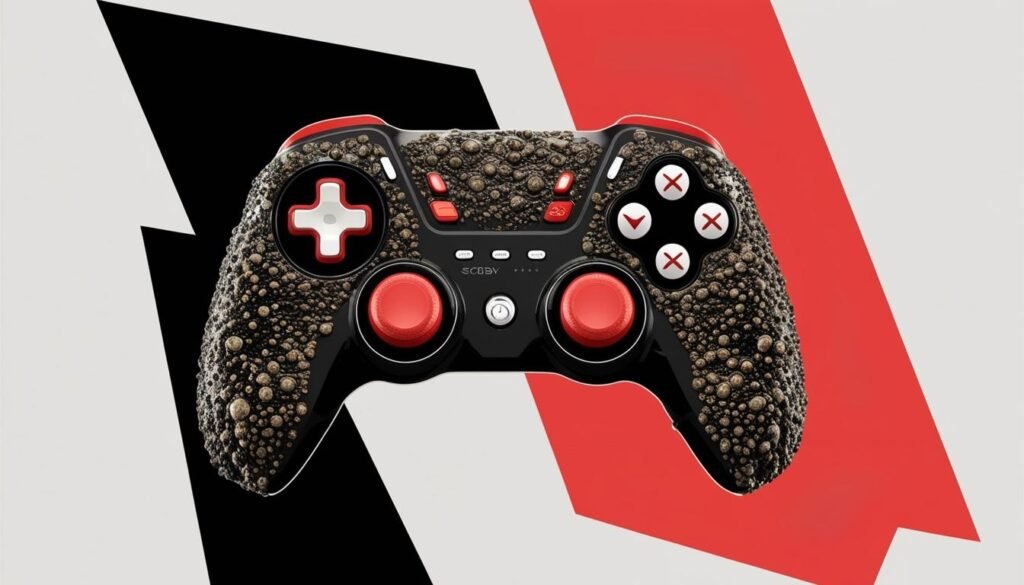A revolutionary gaming controller made from biological materials highlights a future where technology and sustainability intertwine.
A team of designers including Vivien Roussel, Madalina Nicolae, and Marc Teyssier has unveiled an innovative concept known as the BioHybrid Device — a video game controller that uniquely combines biological growth with digital manufacturing. The device is cultivated using SCOBY, a symbiotic culture of bacteria and yeast, and integrates conductive elements and sensors into its structure during the growth process. This groundbreaking approach illustrates a potential shift towards sustainable, interactive technologies that evolve and adapt rather than relying on traditional construction methods.
With its current application as a gaming controller, the BioHybrid Device has implications that reach far beyond entertainment. It serves as a demonstration of how biologically grown interactive devices may seamlessly integrate into various daily functions, potentially leading to the creation of keyboards, wearables, and even architectural elements from biofabrication methods. By proposing the ability to grow technology instead of merely constructing it, the project opens up avenues for significant innovation in materials and manufacturing.
The aesthetics and tactile qualities of the BioHybrid Device contrast sharply with conventional plastic controllers. It integrates organic textures and a futuristic design, redefining the user experience. The project is grounded in an urgent need for sustainable practices amid rising concerns about e-waste, which has become one of the fastest-growing waste streams globally due to the disposable nature of modern computing hardware. Speaking to designboom Magazine, Roussel, Nicolae, and Teyssier noted that “devices like smartphones and computers are rarely designed for repair or reuse, leading to short lifespans despite their material longevity.” The BioHybrid Device presents a sustainable alternative to these trends.
This innovative device represents a transformative shift from extractive production methodologies towards regenerative processes, challenging long-held paradigms about technological innovation. With its emergence, questions arise: What if technology could merge with the environment in a holistic manner? How could this transformation impact our perceptions of technological interfaces? Additionally, it prompts consideration of the responsibilities involved in designing systems that possess a living component.
Aligning with larger movements such as biodesign, speculative design, and the circular economy, the BioHybrid Device fosters discussions about technology’s role in a posthuman future, where distinctions between humans, machines, and nature are increasingly blurred. The project is informed by the philosophies of figures like Yuk Hui and Ron Wakkary, who examine the intertwining of technology with ecological and relational systems. By embedding life within the fabrication process, the designers challenge conventional notions, positioning objects as dynamic participants in their environments.
The BioHybrid Device marks the start of a more extensive inquiry into sustainable living technologies. Future designs aim to enhance biofabrication techniques, investigate new material applications, and broaden functionality. This practical approach addresses the boundaries and implications of a biotechnological future, potentially inspiring a reevaluation of the relationship between humanity, technology, and environmental systems. The project’s presentation took place during an exhibition at the ESC Mediem Kunst Labor in Graz, Austria, showcasing the creative potential of merging biological growth with interactive design.
Source: Noah Wire Services
- https://materialdistrict.com/article/biofabricated-gaming-controller-a-glimpse-into-sustainable-electronics/ – Corroborates the creation of the BioHybrid Device by designers Vivien Roussel, Madalina Nicolae, and Marc Teyssier, and its use of SCOBY to integrate conductive elements and sensors.
- https://materialdistrict.com/article/biofabricated-gaming-controller-a-glimpse-into-sustainable-electronics/ – Supports the implications of the BioHybrid Device beyond entertainment, including its potential for sustainable interactive technologies and integration into daily functions.
- https://www.freethink.com/hard-tech/scientists-hack-kombucha-for-new-materials – Explains the use of SCOBY in creating new materials, similar to the BioHybrid Device’s biofabrication process.
- https://futurematerials.mome.hu/exhibition/biohybrid/ – Details the BioHybrid Device’s manufacturing process using morphogenesis and the integration of electrically interactive elements.
- https://materialdistrict.com/article/biofabricated-gaming-controller-a-glimpse-into-sustainable-electronics/ – Discusses the aesthetic and tactile qualities of the BioHybrid Device and its contrast with conventional plastic controllers.
- https://materialdistrict.com/article/biofabricated-gaming-controller-a-glimpse-into-sustainable-electronics/ – Highlights the urgent need for sustainable practices due to rising e-waste concerns and the BioHybrid Device as a sustainable alternative.
- https://futurematerials.mome.hu/exhibition/biohybrid/ – Supports the transformative shift from extractive production to regenerative processes represented by the BioHybrid Device.
- https://materialdistrict.com/article/biofabricated-gaming-controller-a-glimpse-into-sustainable-electronics/ – Aligns with larger movements such as biodesign, speculative design, and the circular economy, fostering discussions about technology’s role in a posthuman future.
- https://futurematerials.mome.hu/exhibition/biohybrid/ – Mentions the project’s presentation at an exhibition, showcasing the creative potential of merging biological growth with interactive design.
- https://www.freethink.com/hard-tech/scientists-hack-kombucha-for-new-materials – Provides context on the broader applications of biofabrication techniques, similar to those used in the BioHybrid Device, for various material applications.
- https://materialdistrict.com/article/biofabricated-gaming-controller-a-glimpse-into-sustainable-electronics/ – Discusses the future designs and investigations into new material applications and functionality of the BioHybrid Device.


